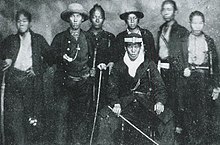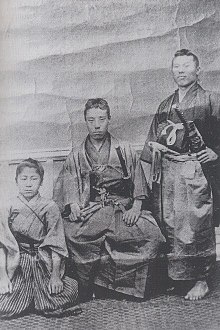| |
Takasugi Shinsaku (高杉 晋作, 27 September 1839 – 17 May 1867) was a samurai from the Chōshū Domain of Japan who contributed significantly to the Meiji Restoration. He used several alias to hide his activities from the Tokugawa shogunate.
Early life
Takasugi Shinsaku was born in the castle town Hagi, the capital of the Chōshū Domain (present-day Yamaguchi Prefecture) as the first son of Takasugi Kochuta, a middle-ranked samurai of the domain and his mother Michi (道). He would have three younger sisters by the name of Tomo (智), Sachi (幸) and Mei (明). He had smallpox at the age of ten, but fortunately he had recovered from it.
Takasugi joined the Shoka Sonjuku, the famous private school of Yoshida Shōin. Takasugi devoted himself to the modernization of Chōshū's military, and became a favorite student of Yoshida. In 1858, he entered the Shōheikō (a military school under direct control of the shōgun at Edo). When his teacher was arrested during the Ansei Purge in 1859, Takasugi visited him in jail. Shōin was later executed in 21 November 1859. In December 1859 he returned home by the clan's command.
In January 1860, Takasugi married Inoue Masa, the second daughter of Yamaguchi retainer and magistrate Inoue Heiemon who was also the friend of his father. Masa was said to be the most beautiful lady in Suō and Nagato provinces. Their marriage was arranged by his parents, with hope that he would take his mind off of his teacher's death in 1859 and to settle down with his new bride.
However, in April 1861, Takasugi would left his home and undertook naval training on the clan's warship Heishinmaru, and travelled to Edo. Later in September he went to study at the Tōhoku region, and there he was associated with Sakuma Shōzan and Yokoi Shōnan.
Foreign experience
Takasugi, in spite of his young age, was an influential factor within Chōshū as one of the most extreme advocates of a policy of seclusion and expelling the foreigners from Japan. Takasugi was implicated in the 31 january 1863 attack on the British legation in Edo.
In spite of Japan's policy of national isolation in the Edo period, in 1862 Takasugi was ordered by the domain to go secretly to Shanghai in China to investigate the state of affairs and the strength of the Western powers. Takasugi's visit coincided with the Taiping Rebellion, and he was shocked by the effects of European imperialism even on the Chinese Empire. Takasugi returned to Japan convinced that Japan must strengthen itself to avoid being colonized by the western powers, or to suffer a similar fate as China. This coincided with the growing Sonnō Jōi ('expel the barbarians and revere the Emperor') movement, which attracted certain radical sections of Japan's warrior class and court nobility, and Takasugi's ideas found ready support in Chōshū and other parts of Japan.
Formation of the Shotai and Kiheitai
Takasugi originated the revolutionary idea of auxiliary irregular militia (shotai). Under the feudal system, only the samurai class was allowed to own weapons. Takasugi promoted the recruitment of commoners into new, socially-mixed paramilitary units. In these units, neither recruitment nor promotion depended (at least in theory), on social status. Farmers, merchants, carpenters and even sumo-wrestlers and Buddhist priests were enlisted, although samurai still formed the majority in most of the Shotai. Takasugi clearly saw that utilization of the financial wealth of the middle-class merchants and farmers could increase the military strength of the domain, without weakening its finances. Since the leaders of Chōshū were unable - and unwilling - to change the social structure of the domain, limited use of peasants and commoners enabled them to form a new type of military without disturbing the traditional society.
In 1863, Takasugi himself founded a special Shotai unit under his direct command called the Kiheitai, which consisted of 300 soldiers (about half of whom were samurai). However, due to his propagation of Sonnō Jōi ideology, Takasugi was imprisoned by the domain's authorities, after an anti-Chōshū coup in Kyoto in the summer of 1863 threatened to jeopardize Chōshū's leading role in national politics.
External and internal crisis
However, Chōshū soon had no choice but to call on Takasugi again. After Chōshū fired upon Western warships in the Straits of Shimonoseki on 25 June 1863, British, French, Dutch and American naval forces bombarded Shimonoseki, the main port of the Chōshū domain the following summer in what was later called the Bombardment of Shimonoseki. This was followed by the landing of French marines. Their fighting against Chōshū units demonstrated the inferiority of traditional Japanese troops against a Western army, and convinced the leaders of the domain of the absolute necessity for a thorough military reform. The Chōshū domain's administration called on Takasugi not only to carry out this reform as ‘Director of Military Affairs’, but he - only 25 years of age - was also entrusted with negotiating peace with the four Western powers.
In view of the humiliation of Chōshū forces against the Western powers, Takasugi had come to the realization that direct confrontation with the foreigners was not an option. Instead, Japan had to learn military tactics, techniques and technologies from the West. Takasugi reorganized his Kiheitai militia into a rifle-unit with the latest modern rifles, and introduced training in Western strategy and tactics. Moreover, Takasugi used his influence with the Sonnô Jôi-movement to promote a more a conciliatory policy towards the West and thus, the ‘movement to expel the barbarians and revere the Emperor’ evolved into an anti-Bakufu movement with the overthrow of the Tokugawa Bakufu as a necessary means to strengthen Japan against the foreigners.
Weakened by the punitive attack by the Western powers, Chōshū was unable to withstand an expedition mounted by the Bakufu in autumn 1864 in retaliation for previous Chōshū attempts to seize control of Kyoto. At first, conservative forces, which favored conciliation with the Bakufu in order to secure the domain, were dominant in Chōshū politics, and Takasugi and some of his compatriots had to leave the domain to avoid renewed imprisonment. Takasugi, with only about a dozen followers, including future political leaders Yamagata Aritomo, Itō Hirobumi and Inoue Kaoru, gathered in Kokura in Kyūshū and prepared an attack on the conservative forces in Chōshū. The subsequent Chōshū civil war began on 13 January 1865.
Takasugi played a major role in this civil war and his Kiheitai militia proved its superiority over old-fashioned samurai forces. With a series of quick strikes and the support of Katsura Kogorō, Takasugi achieved victory by March 1865. He became one of the main arbiters of the Chōshū domain's policy and continued to act as the domain's expert on Western military science, devoting his efforts to importing arms and raising troops. These reforms proved to be successful when Chōshū was victorious on four fronts against the Bakufu's Second Chōshū expedition in 1866, with the Kiheitai itself securing victory on two fronts. Takasugi's efforts had made a small-scale ‘nation in arms’ out of Chōshū, giving it a military strength out of proportion to its relatively small size. With its victory over the Tokugawa forces, the military power of the Bakufu was discredited, and traditionally rival domains decided to join forces with Chōshū in the subsequent battles which led to the Meiji Restoration and the end of the Tokugawa Bakufu.
Death
Takasugi did not live to see this success. He died of tuberculosis in the residence of the bar manager Hayashi Sankuro at Shimonoseki on 17 May 1867, while under the care of his former mistress O-Uno and his wife Masa. His Kiheitai was taken over by his protégé Yamagata Aritomo. Only a year later, Takasugi's dream of overthrowing the Tokugawa Shogunate, which found obvious manifestation in his alternate name Tōgyō (Go to the East) - was fulfilled with the Meiji Restoration.
The Kiheitai was disbanded in 1868, the success of the socially mixed unit and its Western armaments and tactics was an important influence on the development of the Imperial Japanese Army, and on the later system of universal military conscription in Japan.
Legacy
Takasugi Shinsaku, a central figure of the early Meiji Restoration, is as well known for his military talents as he is for his skills as a politician. However, dying at the young age of 28, Takasugi was not to become one of Japan's famous leaders in the subsequent Meiji era. In his hometown - the castle town Hagi, Yamaguchi in south-western Japan - he is still remembered as a mystical and energetic hero, who put all his efforts into opening the way to modernization, westernization and reforms, not only in military matters but in political and social matters as well.
Court rank
- Shoshi’i (正四位, Senior Fourth Rank)
Gallery of birthplace of Takasugi Shinsaku
Takasugi Shinsaku in media
- Takasugi is a secondary character present in the manga and anime Rurouni Kenshin, as well as its OAV adaptation Trust and Betrayal, shown to be in the last stages of his illness. He recruited the young Himura Kenshin into the Kiheitai before allowing Chōshū leader Katsura Kogorō to make him the Hitokiri Battōsai. While portrayed as a brash and ruthless warrior, he is nonetheless wary of his unsavory actions and tried to dissuade Katsura from "corrupting" Kenshin's soul, to no avail. His Japanese voice actor is Wataru Takagi, and his English voice actor is Jason Phelps.
- Takasugi was the inspiration for Takasugi Shinsuke, one of the main and earliest antagonists in the manga series Gin Tama.
- A highly fictionalized version of Takasugi appears in the PSP game Bakumatsu Rock and its anime adaptation. In the game, which is set in the Bakumatsu and has a musical theme, he is depicted as the bass player in a rock band led by Sakamoto Ryōma.
- Takasugi Shinsaku is usually portrayed in most NHK Taiga drama dealing with the Meiji Restoration. Most recent instances would be:
- Ryōmaden, played by Japanese actor Yusuke Iseya
- Hana Moyu, played by Japanese actor Kengo Kora.
- Takasugi Shinsaku was played by Japanese actor Yujiro Ishihara in the 1957 film Sun in the Last Days of the Shogunate.
- Takasugi Shinsaku is credited with the aphorism "Live a pleasant life in the unpleasant world" in the manga Natsuyuki Rendezvous.
- Takasugi Shinsaku is the protagonist in the anime "Bakumatsu".His Japanese voice actor is Nakamura Yuuichi.
Notes
- ^ "The Togyoan Hermitage & Memorial Museum (gravesite of Takasugi Shinsaku)(Yamaguchi) | JAPAN TIMELINE ~See what is happening in Japan now~". JAPAN TIMELINE. Retrieved 2018-07-19.















